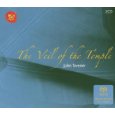I regard The Veil of the Temple as the supreme achievement of my life and the most important work that I have ever composed. It lasts well over seven hours throughout the night until dawn. It is composed in eight cycles like a gigantic prayer wheel with each cycle ascending in pitch and in cycles 1 to 7 using verses from St. John’s Gospel at the centre. The music was deeply influenced by orthodox vigil services, but I wanted to go beyond Christianity and embrace Islam, Hinduism, Buddhism and Judaism and the religion of the American Indians. The soprano solo represents both the Self, Atma, and Mary Magdalene as apostolorum. She journeys through the eight cycles, reaching a total realisation of Self at the end of the last cycle where she recognises Christ’ s divinity.
Each cycle is an entity in itself , and yet is crucial to the whole as the elements of any structure in sacred art. One could say that each cycle has a particular character like the Byzantine tones or the Hindu ragas. The character radiates from the central pivotal gospel, growing in intensity through each one and growing in length. For instance cycle five lasts one and a half hours and cycle one lasts little more than twenty minutes. Also the Prayer of the Heart which starts in cycle one as a single voice becomes a twelve part motet by the time it reaches cycle twelve. Each part of the motet corresponds to a different gospel melody so each gospel has a different spiritual character. The first gospel is solemn, quiet, serene and gentle for example whereas the seventh is highly Indian and melismatic in character. The singer for the first six gospels must be trained by an orthodox psaltist but for the seventh gospel the singer must be guided by a Hindu priest who knows how to chant the Samaveda. The cycles move forward with the relentless of Byzantine ritual rising in glory through the cosmic and musical ascent. It reaches a peak at the end of cycle seven which I hope brings about some form of “transmutation” turning the “lead” of the “old temple” into the “gold” of the new.
I hope that the very long journey through the seven cycles leads us to some kind of spiritual peak of intensity. The awesome sound of the tam tam, temple bowls, Tibetan horn , bells, simatron and organ announce the end of the beginning. “The sun hid it’s rays and the veil of the temple was rent from the top unto the bottom”. This breaks the husk represented by the mosaic law. By breaking the husk we are introduced to the Hindu world as Mary Magdalene representing the Self sings in Sanskrit the words Maya Atma, a musical seesaw of reality and illusion.
By the act of writing The Veil I understood that no single religion could be exclusive. The Veil has become light – there is no longer any veil. This tearing away of the Veil shows that all religions are in the transcendent way inwardly united beneath their outward form.
The CD:
The Booklet.


Pingback: Remembering 'Holy Minimalist' Composer John Tavener | Jacksonville News
Pingback: Remembering 'Holy Minimalist' Composer John Tavener | Texas News
Pingback: Remembering 'Holy Minimalist' Composer John Tavener - RFPRADIO.COM
Pingback: Remembering ‘Holy Minimalist’ Composer John Tavener | Led Zeppelin Site